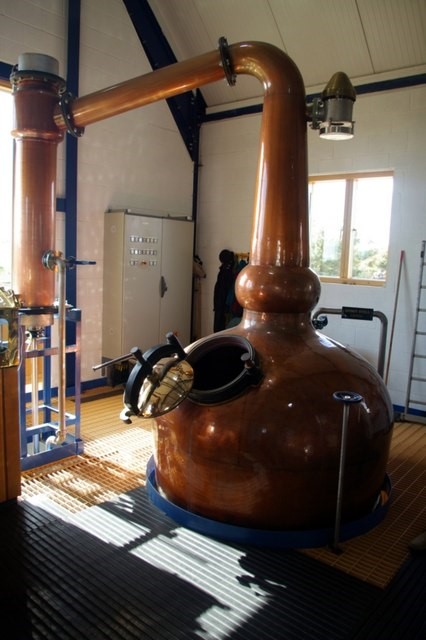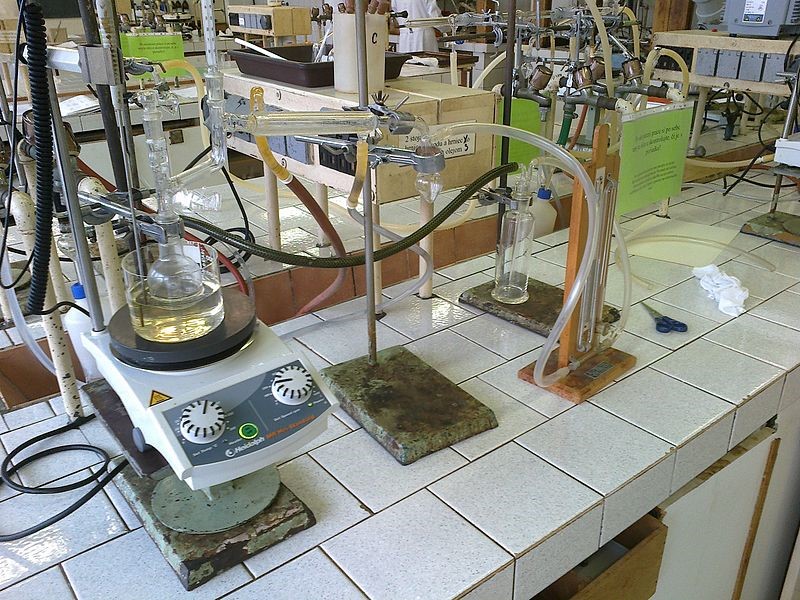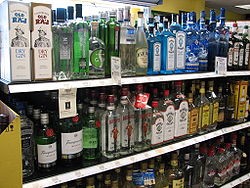Activity 1: Evolution of gin distillation
Activity summary
What you must remember :
- vocabulary associated with distillation
- all three distillation techniques presented
Skills linked to the curriculum :
| Compétences |
Capacités à maîtriser |
APP
ANA |
Connaitre
l’intervention de la chimie dans divers domaines de la vie courante
|
ANA COM |
Citer
l’évolution d’une technique au cours des siècles Savoir
présenter une technique
|
APP
ANA |
Citer
des choix opérés pour répondre à des besoins sociétaux et/ou économiques |
Download activity


Document 1: Simple distillation

Simple distillation is
a procedure by which two liquids with different boiling points can be separated. Simple
distillation (the procedure outlined below) can be used effectively to
separate liquids that have at least fifty degrees difference in their boiling
points. As the liquid being distilled is heated, the vapors that form will be
richest in the component of the mixture that boils at the lowest temperature.
Purified compounds will boil, and thus turn into vapors, over a relatively
small temperature range (2 or 3°C); by carefully watching the temperature in
the distillation flask, it is possible to affect a reasonably good separation.
As distillation progresses, the concentration of the lowest boiling component
will steadily decrease. Eventually the temperature within the apparatus will
begin to change; a pure compound is no longer being distilled. The temperature
will continue to increase until the boiling point of the next-lowest-boiling
compound is approached. When the temperature again stabilizes, another pure
fraction of the distillate can be collected. This process can be repeated until
all the fractions of the original mixture have been separated.
Sources: www.wiredchemist.com and commons.wikimedia.org
Document 2: Gin production through traditional fractional distillation

[..] The still is heated,
using a steam coil or jacket, to remove the essential oils (less than 5% of the
weight) which give the flavouring to the spirit. The first distillate
'runnings' are re-circulated until an appropriate standard and strength (over
90% ABV) is reached. The lower quality early part of the run ('foreshots') and
end of the run ('feints') [..] are run
off to be redistilled. Only the 'middle run' is used to produce high quality gin; this is run off at about
80-85% ABV. The product then goes through a quality control 'Tasting Panel' and
may also be analysed by gas chromatography to ensure that it meets the required
specification. This ensures product consistency. [..]
The
gin is then brought to the required EU legal minimum alcohol level - at least
37.5% ABV, - by the addition of pure demineralised water. It is now ready for
bottling as it does not require any period of maturation.
Sources: www.ginvodka.org/history/ginProduction.asp and commons.wikimedia.org
Document 3: Comparison of a novel distillation method versus a traditional distillation method in a model gin system

This research studied a novel form of distillation
(high vacuum distillation) as a method for preserving volatile aroma chemicals
important to the organoleptic attributes of a four botanical model gin as well
as the degradation products generated during the heating required in
traditional methods of gin distillation. A model gin was made of dried juniper
berries (Juniperus communis), coriander seed (Coriandrum sativum), angelica
root (Angelica archangelica), and dry lemon peel (Citrus limonum). This was
distilled on a traditional still utilizing atmospheric pressure and a heating
mantel to initiate phase separation as well as a novel still (high vacuum)
utilizing high vacuum pressures below 0.1 mmHg and temperatures below -15
degrees C to initiate phase separation. The degradation products (alpha-pinene,
alpha-phellandrene, E-caryophyllene, and beta-myrcene) were present at greater
levels (approximately 10 times) in the traditional still-made gin as compared
to the novel gin.
Source :
commons.wikimedia.org
Acquiring vocabulary: filling in the blanks
| French |
English |
| Une
méthode, un procédé |
|
| Température
d’ébullition |
|
| Un montage |
|
| Un mélange |
|
| La première "coupe" |
|
|
A still |
|
ABV: Alcohol by volume |
|
A novel method |
| |
Degradation products |
Questions
1. Which three distillation techniques are presented in the documents?
2. Explain the differences in all three methods.
3. According to document 3, what seem to be the advantages of high vacuum distillation compared to traditional still distillation?
Presentation
Prepare a 5 min presentation of the simple distillation method.
Modifié le: lundi 9 septembre 2019, 13:11





